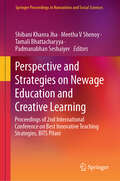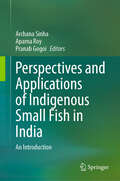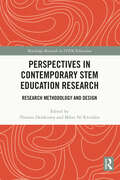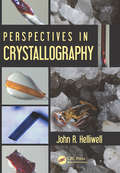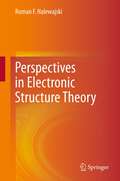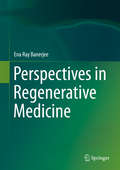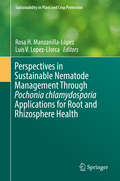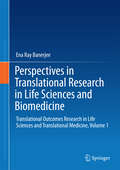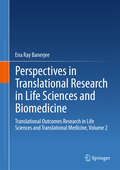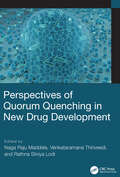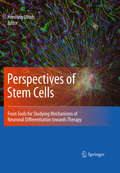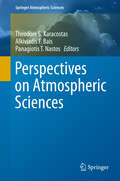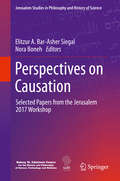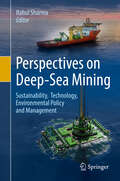- Table View
- List View
Personhood and Social Robotics: A psychological consideration (Explorations in Social Psychology)
by Raya A JonesAn exponentially growing industry, human robot interaction (HRI) research has drawn predominantly upon psychologists’ descriptions of mechanisms of face-to-face dyadic interactions. This book considers how social robotics is beginning unwittingly to confront an impasse that has been a perennial dilemma for psychology, associated with the historical ‘science vs. art’ debate. Raya Jones examines these paradigmatic tensions, and, in tandem, considers ways in which the technology-centred discourse both reflects and impacts upon understanding our relational nature. Chapters in the book explore not only how the technology-centred discourse constructs machines as us, but also how humans feature in this discourse. Focusing on how the social interaction is conceptualised when the human-robot interaction is discussed, this book addresses issues such as the long-term impact on persons and society, authenticity of relationships, and challenges to notions of personhood. By leaving aside terminological issues, Jones attempts to transcend ritual of pitching theories against each other in order to comprehensively analyse terms such as subjectivity, self and personhood and their fluid interplay in the world that we inhabit. Personhood and Social Robotics will be a key text for postgraduate students, researchers and scholars interested in the connection between technology and human psychology, including psychologists, science and technology studies scholars, media studies scholars and humanists. The book will also be of interest to roboticists and HRI researchers, as well as those studying or working in areas of artificial intelligence and interactive technologies more generally.
Personnel Selection in the Pattern Evidence Domain of Forensic Science: Proceedings of a Workshop
by Engineering Medicine National Academies of SciencesIn July 2016 The National Academies of Sciences, Engineering, and Medicine convened a workshop with the goal of bringing together industrial and organizational (I-O) psychologists, experts on personnel selection and testing, forensic scientists, and other researchers whose work has a nexus with workforce needs in the forensic science field with a focus on pattern evidence. Participants reviewed the current status of selection and training of forensic scientists who specialize in pattern evidence and discussed how tools used in I-O psychology to understand elements of a task and measure aptitude and performance could address challenges in the pattern evidence domain of the forensic sciences. This publication summarizes the presentations and discussions from the workshop.
Perspective and Strategies on Newage Education and Creative Learning: Proceedings of 2nd International Conference on Best Innovative Teaching Strategies, BITS Pilani (Springer Proceedings in Humanities and Social Sciences)
by Shibani Khanra Jha Meetha V Shenoy Tamali Bhattacharyya Padmanabhan SeshaiyerThis book presents the proceedings of the International Conference on Best Innovative Teaching Strategies (ICOBITS) at BITS Pilani on Feb 9-11, 2023. It brings together global academicians, researchers, and industry experts to delve into innovative teaching-learning practices. Meticulously selected and reviewed by professionals, the proceedings offer cross-cutting perspectives and strategies in education and creative learning. It is organized into four parts and covers Innovative Pedagogical Practices for Technology Enhanced Learning, Technology, Society and Industry in Higher Education, STEM Education and Cultural Studies, Gender Studies and Sustainability in Higher Education. It provides insights into assessment tools for effectively evaluating the efficiency of teaching methods. Part one explores ICT, digital classrooms, metaverse-based teaching, gamification, and AI-ML-based practices. Part two delves into the humanistic approach in technical education, social networking as an educational tool, and outcome-based assessment needs. Part three addresses future educators' requirements through multidisciplinary collaboration in STEM education. Part four discusses gender equity, structured social inclusion and cultural skills in teaching-learning practices. This book is a valuable resource for academicians, researchers, policymakers, administrators, technocrats, and developers actively engaged in education technology across disciplines such as Engineering, Sciences, Management, Humanities, and Social Sciences.
Perspectives and Applications of Indigenous Small Fish in India: An Introduction
by Archana Sinha Aparna Roy Pranab GogoiThis contributed volume covers all aspects of small indigenous fish for nutritional and livelihood security. The availability, descriptions and identification of common small indigenous fish provides potential and prospects of fish production from inland open water system. In addition, individual chapters are added on growth, feeding, diseases and health management of these small fishes. Essential information is provided on packaging and transport of these fishes. Specific chapters provide information on nutritional value of fishes, value addition and product development by using small indigenous fish species in different regions of the country. Further topics include small fishes of ornamental value, indigenous technical knowledge, climate change impact, conservation and management of small indigenous fish diversity. This book supports the academicians, farmers, entrepreneurs and fisheries professionals involved in gaining the knowledge and skills needed to contribute in nutritional and livelihood security of the nation.
Perspectives for Biodiversity and Ecosystems (Environmental Challenges and Solutions)
by Carsten HobohmThe novelty of the book is a strong focus on perception, perspectives and prediction by scientists with profound insight into the ecology of ecosystems or into human demands and activity. The challenge is to bridge from empirical data and the knowledge of the past to the possibilities of the performance in the future. We assume that there is scope for more cooperation between the fields of ecology and practical philosophy or other social sciences in organising ecosystems and shaping the cultural future of humankind, and that such collaboration should be accorded considerably more priority. This book deals with environmental processes seen within a framework of the nature of ecosystems and human cultures. The future of the environment, the development of ecosystems and effective nature conservation management are the essentials of this book. Human nature and culture, and in particular their interactions, are interpreted as a set of rules and as given. The aim is not only to assess the significance of human influence on species composition and biodiversity but also to weigh up the subsequent potentials for action. In this book we will analyze the problems independently of one another, even if they are interconnected. This book focuses on perspectives and prognoses for the impacts of anthropogenic activity on ecosystems and thus on species conservation. Its goal is to improve assessments of the impacts of human activity on the environment. We are aware that prognoses have very often proven to be false. It is difficult to impossible to be able to predict with precision how evolution and ecosystems will change in future under anthropogenic influence. This strengthens our resolve to attempt to retain the highest possible degree of scientific integrity and professionalism and not to shy away from expressing the uncertainty of our own ideas and prognoses. We venture prognoses in this book and we will fail. However, we hope that we will be wrong on the right side.
Perspectives in Contemporary STEM Education Research: Research Methodology and Design (Routledge Research in STEM Education)
by Thomas Delahunty Máire Ní RíordáinThis book presents an overview of the methodological innovations and developments present in the field of STEM education research as well as providing a practically orientated resource on research method design more broadly. Featuring a range of international contributors in the field, the book provides a compendium of exemplary innovative methodological designs, implementations, and analyses that answer a variety of research questions relating to STEM education disciplines. Charting the thinking behind the design and implementation of successful research investigations, the book’s two parts present an accessible and pragmatically framed set of chapters that cover a range of important methodological areas presented by active researchers in the field. Ultimately, this book presents a comprehensive resource that explores the act of educational research as related to STEM. By showcasing key methodological principles with guidance on practical approaches underpinned by theory, the book offers scholarly research-informed suggestions for practice. It will be of great interest to researchers, academics, and students in the fields of STEM education and education research methods, as well as educational research more broadly.
Perspectives in Crystallography
by John R. HelliwellCrystallography is one of the most multidisciplinary sciences, with roots in fields as varied as mathematics, physics, chemistry, biology, materials science, computation and earth and planetary science. The structural knowledge gained from crystallography has been instrumental in acquiring new levels of understanding in numerous scientific areas. P
Perspectives in Dynamical Systems I — Applications: DSTA, Łódź, Poland, December 6–9, 2021 (Springer Proceedings in Mathematics & Statistics #453)
by Jan AwrejcewiczThis proceedings volume gathers selected, peer-reviewed papers presented at the Dynamical Systems Theory and Applications International Conference - DSTA 2021, held virtually on December 6-9, 2021, organized by the Department of Automation, Biomechanics, and Mechatronics at Lodz University of Technology, Poland. This volume concentrates on studies on applications, while Volume II focuses on numerical and analytical approaches.Being a truly international conference, this 16th iteration of DSTA received submissions from authors representing 52 countries. The program covered both theoretical and experimental approaches to widely understood dynamical systems, including topics devoted to bifurcations and chaos, control in dynamical systems, asymptotic methods in nonlinear dynamics, stability of dynamical systems, lumped mass and continuous systems vibrations, original numerical methods of vibration analysis, nonsmooth systems, dynamics in life sciences and bioengineering, as well as engineering systems and differential equations.DSTA conferences aim to provide a common platform for exchanging new ideas and results of recent research in scientific and technological advances in modern dynamical systems. Works contained in this volume can appeal to researchers in the field, whether in mathematics or applied sciences, and practitioners in myriad industries.
Perspectives in Dynamical Systems II — Numerical and Analytical Approaches: DSTA, Łódź, Poland December 6–9, 2021 (Springer Proceedings in Mathematics & Statistics #454)
by Jan AwrejcewiczThis proceedings volume gathers selected, peer-reviewed papers presented at the Dynamical Systems Theory and Applications International Conference - DSTA 2021, held virtually on December 6-9, 2021, organized by the Department of Automation, Biomechanics, and Mechatronics at Lodz University of Technology, Poland. This volume focuses on numerical and analytical approaches, while Volume I concentrates on studies on applications.Being a truly international conference, this 16th iteration of DSTA received submissions from authors representing 52 countries. The program covered both theoretical and experimental approaches to widely understood dynamical systems, including topics devoted to bifurcations and chaos, control in dynamical systems, asymptotic methods in nonlinear dynamics, stability of dynamical systems, lumped mass and continuous systems vibrations, original numerical methods of vibration analysis, non-smooth systems, dynamics in life sciences and bioengineering, as well as engineering systems and differential equations.DSTA conferences aim to provide a common platform for exchanging new ideas and results of recent research in scientific and technological advances in modern dynamical systems. Works contained in this volume can appeal to researchers in the field, whether in mathematics or applied sciences, and practitioners in myriad industries.
Perspectives in Electronic Structure Theory
by Roman F. NalewajskiThe understanding in science implies insights from several different points of view. Alternative modern outlooks on electronic structure of atoms and molecules, all rooted in quantum mechanics, are presented in a single text. Together these complementary perspectives provide a deeper understanding of the localization of electrons and bonds, the origins of chemical interaction and reactivity behavior, the interaction between the geometric and electronic structure of molecules, etc. In the opening two parts the basic principles and techniques of the contemporary computational and conceptual quantum chemistry are presented, within both the wave-function and electron-density theories. This background material is followed by a discussion of chemical concepts, including stages of the bond-formation processes, chemical valence and bond-multiplicity indices, the hardness/softness descriptors of molecules and reactants, and general chemical reactivity/stability principles. The insights from Information Theory, the basic elements of which are briefly introduced, including the entropic origins and Orbital Communication Theory of the chemical bond, are the subject of Part IV. The importance of the non-additive (interference) information tools in exploring patterns of chemical bonds and their covalent and ionic components will be emphasized.
Perspectives in Environmental Toxicology
by Kavindra Kumar KesariThis book is a valuable contribution to the debate about the harmful effects of environmental toxicants on human health, which is a growing concern in the 21st century. Complementary chapters decipher the phenomena and highlight the latest developments in environmental toxicology, providing readers with a comprehensive overview of environmental toxicology and human health.Since the toxicants in question are not only chemical or biological in nature, but also include man-made electromagnetic fields, the book explores in detail multidisciplinary approaches to environmental toxicology, with a focus on the following five aspects: 1. The effects of man-made electromagnetic fields (RF-EMF) on human health proposed mechanisms and biological effects and measures). 2. An overview of nanotoxicity, nanomedicine and cancer research. 3. A bio-computational approach to the molecular interaction of environmental carcinogens with DNA. 4. The toxicology of environmental pollutants in the air, dust, soil, water and natural toxins in the environment: exposure and health. 5. Social insects as environmental indicators of ecotoxicological effects in different ecosystems.The book analyzes the carcinogenic, mutagenic, genotoxic and neurotoxic effects of both anthropogenic and natural toxins present in water, soil, air and our surroundings in the form of electro-pollution or electro-smog.
Perspectives in Regenerative Medicine
by Ena Ray BanerjeeThe information given in this book tries to capture the essence of the sheer dynamicity of the cell along with useful tips on how to address critical rate limiting steps in the process of exploration and investigation of its capacity to regenerate, rebuild and replenish from within. The definitions of stem cells, stemness, and the niche concept continue to undergo revisions. In adult vertebrates, hematopoietic and some non-hematopoietic progenitors are synthesized within specialized niches of bone marrow. They migrate to designated tissues, and are either trans-differentiated or become quiescent and settle down. These form the stem cell niche reservoir in all tissues. Not only the primary hematopoietic tissue but all organs and tissues are also capable of generating progenitors which are either synthesized from these migrants or are direct recruits from other tissues. In the niches, the cells settle down and await their turn to either make more clones like themselves or differentiate and mobilize in an exigency. Thus progenitors are important reserves, to be multiplied and deployed or travel as important message bearing molecules via blood as circulating progenitors which can home to their allocated destinations. Upon reaching, specific integrins and selectins help them "dock" and "port" and they may be reprogrammed to induce further differentiation and help repopulate the denuded tissue. In pulmonary fibrosis and asthma, progenitors from both systemic circulation and local stem cell niches have been found to participate in the myriad ramifications of repair, replacement and regeneration of lost or diseased tissue. Whether they are lung specific or global in origin and role remain to be explored. Research tools, fundamental concepts, techniques, methodologies and standard operating protocols and animal models and human extrapolations, have been discussed in a concise way along with detailed description and discussion on the appropriate rationale to introduce the subject to the casual reader and provide valuable tactical information to the specialist in Regenerative Medicine. I sincerely hope you enjoy the work and appreciate the hard work that has gone into designing and executing elegant experiments by many researchers in the field. The branch is multi-disciplinary and I hope that the readers will not be limited to biologists alone.
Perspectives in Space Surveillance (MIT Lincoln Laboratory Series)
by Ramaswamy Sridharan Antonio PensaThe development of deep space surveillance technology and its later application to near-Earth surveillance, covering work at Lincoln Laboratory from 1970 to 2000.In the 1950s, the United States and the Soviet Union raced to develop space-based intelligence gathering capability. The Soviets succeeded first, with SPUTNIK I in 1957. The United States began to monitor the growing Soviet space presence by developing technology for the detection and tracking of man-made resident space objects (RSOs) in near-Earth orbit. In 1972, the Soviet Union launched a satellite into deep space orbit, and the U.S. government called on MIT Lincoln Laboratory to develop deep space surveillance technology. This book describes these developments, as well as the later application of deep space surveillance technology to near-Earth surveillance, covering work at Lincoln Laboratory on space surveillance from 1970 to 2000.The contributors, all key participants in developing these technologies, discuss topics that include narrow beam, narrow bandwidth radar for deep surveillance; wide bandwidth radar for RSO monitoring; ground-based electro-optical deep space surveillance and its adaptation for space-based surveillance; radar as the means of real-time search and discovery techniques; methods of analyses of signature data from narrow bandwidth radars; and the collision hazard for satellites in geosynchronous orbit, stemming initially from the failure of TELSTAR 401. They also describe some unintended byproducts of this pioneering work, including the use of optical space surveillance techniques for near-Earth asteroid detection. ContributorsRick Abbott, Robert Bergemann, E.M. Gaposchkin, Israel Kupiec, Richard Lambour, Antonio F. Pensa, Eugene Rork, Jayant Sharma, Craig Solodyna, Ramaswamy Sridharan, J. Scott Stuart, George Zollinger
Perspectives in Sustainable Nematode Management Through Pochonia chlamydosporia Applications for Root and Rhizosphere Health
by Rosa H. Manzanilla-López Luis V. Lopez-LlorcaThis volume reviews our current knowledge and novel research areas on Pochonia chlamydosporia, a cosmopolitan fungus occurring in soils as a saprophyte yet capable of colonizing the rhizosphere of crops as an endophyte and behaving as a parasite of eggs of plant-parasitic nematodes. The book is divided into six sections containing 18 chapters, starting with a historical background chapter, followed by 16 chapters, each contributed by experts, concerning those key aspects necessary to work with this biocontrol agent in a multidisciplinary treatise. Topics covered include systematics, biology, nematode-fungus interactions, nematode management strategies, secondary metabolites, and other methods including more novel research areas such as molecular, –omics, plant growth enhancement and endophytic abilities of P. chlamydosporia. The final chapter deals with the future perspectives of P. chlamydosporia research.
Perspectives in Translational Research in Life Sciences and Biomedicine
by Ena Ray BanerjeeThe present book addresses the multi-disciplinary nature of Translational Outcomes Research, which is a watershed for nearly all the disciplines of Life and Health Sciences, along with the Materials Sciences including but not limited to Zoology, Botany, Microbiology, Biochemistry, Physiology, Nanotechnology, the Medical Sciences, Bioengineering, Biophysics, Medicinal Chemistry, Structural Biology, Biostatistics and Bioinformatics. This book, for the first time, addresses the basic premises of fundamental research in facilitating drug discovery. One chapter is dedicated to a novel generation of platforms with novel camelid antibodies and their technological extensions, while another focuses on functional food and nutraceuticals. The book begins with a thorough overview of what translational outcomes research connotes and what the current status of research in the area is, and goes on to elucidate various pertinent preclinical disease models and their uses in basic and application based research in the Life Sciences. How basic approaches to screening and characterization vis-à-vis their role in amelioration of the two cardinal problems of inflammation and degeneration involved in most diseases is elucidated. The book ends with a discussion of the relevance and importance of using Bio Green technology in Translational Outcomes, addressing the need to fill the gap between academia and industry and clinics that can arise through direct or indirect collaboration between the stakeholders and emphasizing the need for an eco-friendly approach so as not to jeopardize the fine balance that holds life on earth in harmony.
Perspectives in Translational Research in Life Sciences and Biomedicine
by Ena Ray BanerjeeThe present book addresses the multi-disciplinary nature of Translational Outcomes Research, which is a watershed for nearly all the disciplines of Life and Health Sciences, along with the Materials Sciences including but not limited to Zoology, Botany, Microbiology, Biochemistry, Physiology, Nanotechnology, the Medical Sciences, Bioengineering, Biophysics, Medicinal Chemistry, Structural Biology, Biostatistics and Bioinformatics. This book, for the first time, addresses the basic premises of fundamental research in facilitating drug discovery. One chapter is dedicated to a novel generation of platforms with novel camelid antibodies and their technological extensions, while another focuses on functional food and nutraceuticals. The book begins with a thorough overview of what translational outcomes research connotes and what the current status of research in the area is, and goes on to elucidate various pertinent preclinical disease models and their uses in basic and application based research in the Life Sciences. How basic approaches to screening and characterization vis-#65533;-vis their role in amelioration of the two cardinal problems of inflammation and degeneration involved in most diseases is elucidated. The book ends with a discussion of the relevance and importance of using Bio Green technology in Translational Outcomes, addressing the need to fill the gap between academia and industry and clinics that can arise through direct or indirect collaboration between the stakeholders and emphasizing the need for an eco-friendly approach so as not to jeopardize the fine balance that holds life on earth in harmony.
Perspectives in Urban Ecology
by Wilfried EndlicherThis book gives an interdisciplinary overview on urban ecology. Basic understanding of urban nature development and its social reception are discussed for the European Metropolitan Area of Berlin. Furthermore, we investigate specific consequences for the environment, nature and the quality of life for city dwellers due to profound changes such as climate change and the demographic and economic developments associated with the phenomena of shrinking cities. Actual problems of urban ecology should be discussed not only in terms of natural dimensions such as atmosphere, biosphere, pedosphere and hydrosphere but also in terms of social and cultural dimensions such as urban planning, residence and recreation, traffic and mobility and economic values. Our research findings focus on streets, new urban landscapes, intermediate use of brown fields and the relationships between urban nature and the well-being of city dwellers. Finally, the book provides a contribution to the international discussion on urban ecology.
Perspectives of Hydrosilylation Reactions (Topics in Organometallic Chemistry #72)
by Bogdan Marciniec Hieronim MaciejewskiThis volume describes the latest advances and perspectives in hydrosilylation, with a focus on new organometallic catalysts and their mechanistic aspects. Hydrosilylation is the reaction of ≡SiH with carbon-carbon, carbon-heteroatom or heteroatom-heteroatom bonds and is the most fundamental and elegant method for laboratory and industrial synthesis of organosilicon molecular and macromolecular compounds. Yet these reactions do require a catalyst, for which initially homogeneous noble metal catalyst, mainly platinum, rhodium, iridium or ruthenium were used. However the high prices, metallic residues of these valuable catalysts as well as issues with product purification, did increase the interest in developing new catalysts. Noteworthy in this regard are the recently developed hydrosilylation reactions using catalysts based on earth-abundant transition metals (for example Mn, Fe, Co, Ni) and heterogeneous catalysts presented here. This volume of Topics in Organometallic Chemistry is written for scientists interested in silicon chemistry and its catalytic aspects, but can also be used as valuable handbook for postgraduate and advanced undergraduate students working with organometallic chemistry, catalysis as well as synthesis of fine chemicals.
Perspectives of Quorum Quenching in New Drug Development
by Naga Raju Maddela, Venkataramana Thiriveedi, Rathna Silviya LodiAntibiotic resistance in pathogen microorganisms is a major global concern, especially the formation of biofilms. Quorum quenching has been practically used to control biofilm growth, and this indicates a promising hope for the development of new drugs for the control of biofilm-forming pathogens. This book provides a single source of information about two issues: the biology of quorum sensing and quorum quenching, and the perspectives of quorum quenching in new drug development. The text covers the latest literature from the last ten years and insights into quorum quenching and its need in medicine as an anti-virulence strategy.Features: Exclusively focuses on quorum quenching and its ability to be used as an alternative to antibiotics in the control of multidrug-resistant pathogens. Reviews the latest literature and case studies of the last ten years in the field of quorum sensing and quorum quenching. Promotes a new approach to the development of the next generation of antibacterial drugs. In the wake of rising antibiotic drug resistance, it is crucial to develop an alternative approach to control bacterial infection diseases and quorum quenching appears to be a promising strategy in the development of new medicines.
Perspectives of Stem Cells
by Henning UlrichThe field of stem cell biology is geared towards translation into clinical practice through in vitro tissue production and regeneration therapy. Since the discovery of adult neurogenesis, much attention has been put on the study of differentiation of stem cells into neural cell types and the development of model systems for stroke and neurodegenerative diseases. In addition to chapters on therapeutic applicability of embryonic, very small-embryonic like, mesenchymal stem and neural progenitor cells, this book covers signalling mechanisms guiding induction to differentiation and cell diversification. Furthermore, fundamental aspects of stem cell biology and neurogenesis, such as the importance of proliferation induction, programmed cell death and the function of glia in differentiation of stem cells and development of neuronal circuits, are also highlighted. In vitro cultures of embryonic, mesenchymal and neural stem cells as well as mobilization of endogenous stem and precursor cells for brain repair and replacement therapy in neurological disorders are important issues of this book. Each chapter is written by researchers who are leaders in the field and provides an invaluable resource for information on the most current advances in the field and possible therapeutic applications, with discussions of controversial issues and areas of emerging importance. By providing an up-to-date and critical view of the state of Science, we hope that this book shall be a base for exciting scientific ideas regarding functions and therapeutic applications of stem cells in the adult brain. The book is directed to neuroscientists, physicians, students and all who are engaged and interested in the exciting and rapidly expanding field of modern neuroscience and stem cell biology.
Perspectives on Atmospheric Sciences
by Panagiotis T. Nastos Theodore S. Karacostas Alkiviadis F. BaisThis book provides the proceedings of the 13th International Conference of Meteorology, Climatology and Atmospheric Physics (COMECAP 2016) that was held in Thessaloniki from 19 to 21 September 2016. The Conference addresses fields of interest for researchers, professionals and students related to the following topics: Agricultural Meteorology and Climatology, Air Quality (Indoor and Outdoor), Applied Meteorology and Climatology, Applications of Meteorology in the Energy sector, Atmospheric Physics and Chemistry, Atmospheric Radiation, Atmospheric Boundary layer, Biometeorology and Bioclimatology, Climate Dynamics, Climatic Changes, Cloud Physics, Dynamic and Synoptic Μeteorology, Extreme Events, Hydrology and Hydrometeorology, Mesoscale Meteorology, Micrometeorology-Urban Microclimate, Remote Sensing- Satellite Meteorology and Climatology, Weather Analysis and Forecasting. The book includes all papers that have been accepted after peer review for presentation in the conference.
Perspectives on Causation: Selected Papers from the Jerusalem 2017 Workshop (Jerusalem Studies in Philosophy and History of Science)
by Elitzur A. Bar-Asher Siegal Nora BonehThis book explores relationships and maps out intersections between discussions on causation in three scientific disciplines: linguistics, philosophy, and psychology. The book is organized in five thematic parts, investigating connections between philosophical and linguistic studies of causation; presenting novel methodologies for studying the representation of causation; tackling central issues in syntactic and semantic representation of causal relations; and introducing recent advances in philosophical thinking on causation. Beyond its thematic organization, readers will find several recurring topics throughout this book, such as the attempt to reduce causality to other non-causal terms; causal pluralism vs. one all-encompassing account for causation; causal relations pertaining to the mental as opposed to the physical realm, and more. This collection also lays the foundation for questioning whether it is possible to evaluate available philosophical approaches to causation against the variety of linguistic phenomena ranging across diverse lexical and grammatical items, such as bound morphemes, prepositions, connectives, and verbs. Above all, it lays the groundwork for considering whether the fruits of the psychological-cognitive study of the perception of causal relations may contribute to linguistic and philosophical studies, and whether insights from linguistics can benefit the other two disciplines.
Perspectives on Classification in Synthetic Sciences: Unnatural Kinds (History and Philosophy of Technoscience)
by Julia R. S. BurstenThis volume launches a new series of contemporary conversations about scientific classification. Most philosophical conversations about kinds have focused centrally or solely on natural kinds, that is, kinds whose existence is not dependent on the scientific process of synthesis. This volume refocuses conversations about classification on unnatural, or synthetic, kinds via extensive study of three paradigm cases of unnatural kinds: nanomaterials, stem cells, and synthetic biology.
Perspectives on Deep-Sea Mining: Sustainability, Technology, Environmental Policy and Management
by Rahul SharmaThis book is a sequel to ’Deep-Sea Mining: Resource Potential, Technical and Environmental Considerations’ (2017) and ‘Environmental Issues of Deep-Sea Mining: Impacts, Consequences and Policy Perspectives’ (2019), and aims to provide a comprehensive volume on different perspectives of deep-sea mining from specialists around the world. The work is timely, as deep-sea minerals continue to enthuse researchers involved in activities such as ascertaining their potential as alternative sources for critical metals for green energy and other industrial applications, as well as technology development for their sustainable exploration and exploitation, while addressing environmental concerns. With a steady increase in the number of contractors having exclusive rights over large tracts of seafloor in the ‘Area’, i.e. area beyond national jurisdictions, the International Seabed Authority, mandated with the responsibility of regulating such activities, is in the process of developing a code for exploitation of deep-sea minerals. These, coupled with growing interest among private entrepreneurs, investment companies and policy makers, underscore the need for updated information to be made available in one place on the subject of deep-sea mining. The book evaluates the potential and sustainability of mining for deep-sea minerals compared to other land-based deposits, the technologies needed for mining and processing of ores, the approach towards environmental monitoring and management, as well as the regulatory frameworks and legal challenges to manage deep-sea mining activities. The book is expected to serve as an important reference for all stakeholders including researchers, contractors, mining companies, regulators and NGOs involved in deep-sea mining.
Perspectives on Design Education in India and Asia
by Venkatesh Rajamanickam Ravi Poovaiah Peer M. Sathikh Karin G. OenThis book spotlights design and media education in Asia, with contributors providing their reflections on curriculum development, pedagogy, and practice from Australia, China, Japan, India, Mongolia, the Philippines, Singapore, and Turkey.The chapters provide in-depth and specific examples of how curricula and educational resources have been organised with respect to a wide variety of subjects, including aesthetics, engineering, and practice-based coursework. These course plans have also been adapted to respond to questions about integrating emerging technologies in the classroom and addressing changing industry needs as well as the need to encourage resilience and leadership skills across student and faculty cohorts. Although not an analysis of educational and industrial policies, some key documents such as The India Design Report of 1958 by Charles and Ray Eames and India’s National Education Policy of 2020 are referenced to provide important background information for understanding the past, present, and future of the design education ecosystem across the region.Presenting both historical context and practical contemporary applications of curricula in specific universities and design schools, this volume is compiled to share resources among faculty and researchers interested in global Asian design pedagogy who have previously relied upon publications centred on the UK and US contexts. It will appeal to design educators and anyone responsible for design education curricula across the Asian region and beyond.


